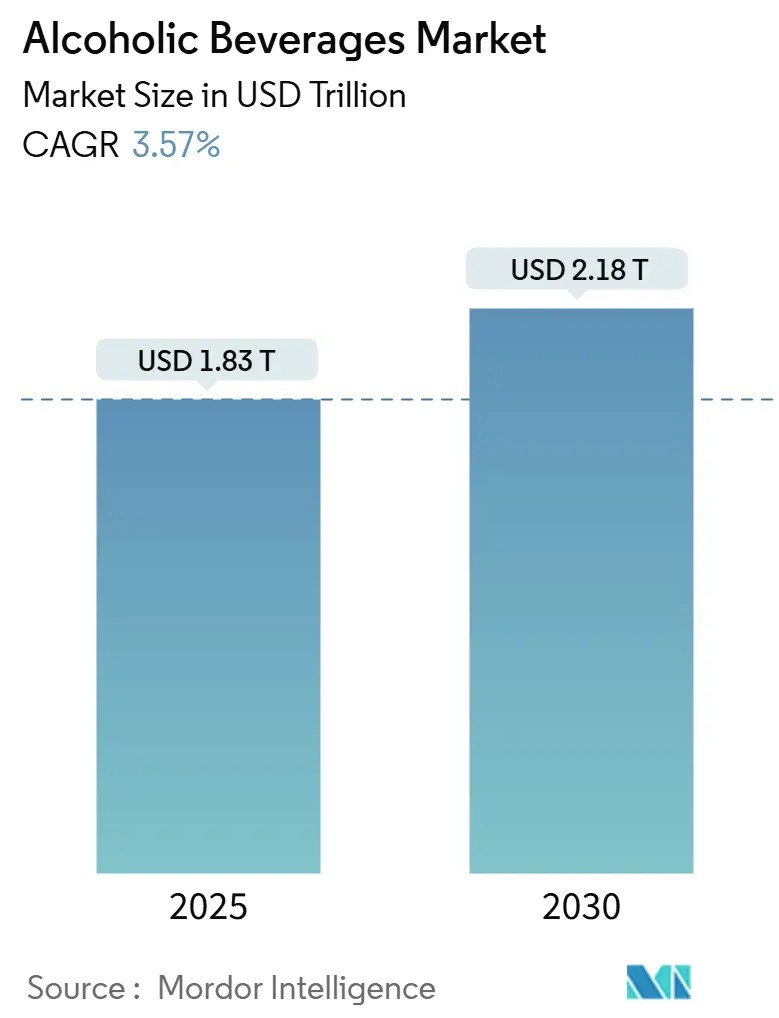Global Alcoholic Beverages Market Set to Surpass $2 Trillion by 2030 Amid Shifting Consumer Trends
Premiumization, sustainability, and digital innovation drive industry growth as producers adapt to evolving regulations and health-conscious preferences worldwide
2025-10-03

The global alcoholic beverages market is expected to grow from $1.83 trillion in 2025 to $2.2 trillion by 2030, according to a recent report by Mordor Intelligence. This growth, at a compound annual rate of 3.57%, is being driven by several key trends, including the premiumization of products, changes in government policies, the recovery of international tourism, and evolving consumer preferences for low- and no-alcohol options.

Premiumization remains a central force in the industry. Major producers are focusing on higher-end products and reducing their lower-margin offerings. Regional distillers are expanding their craft selections to attract the growing middle class, especially in Asia-Pacific, where demand for spirits, beer, wine, and craft beverages continues to rise. The report notes that omnichannel distribution models—combining online sales, subscription services, and partnerships with grocery retailers—are changing how consumers purchase alcohol, making it easier for them to discover new brands and products.
Sustainability is also becoming a core business strategy rather than just a marketing tool. Producers are investing in recyclable packaging such as aluminum cans and eco-friendly closures. Some distilleries are adopting “water positive” practices to appeal to environmentally conscious consumers. Innovations like paper-based liquor bottles and smart packaging are helping brands stand out by combining sustainability with functionality.
Tourism is playing a significant role in boosting demand for alcoholic beverages worldwide. As more travelers seek culinary and cultural experiences, there has been an increase in demand for premium local labels. Souvenir purchases, duty-free shopping, and collaborations with airlines and hotels are helping regional brands reach a global audience.
The market is also seeing a shift toward low- and non-alcoholic beverages. Public health concerns have led to stricter regulations in some countries, such as mandatory cancer warning labels in Ireland and warnings from the U.S. Surgeon General about alcohol-related cancer risks. In response, leading companies like Constellation Brands and Diageo are investing heavily in non-alcoholic and low-alcohol portfolios to reach new consumers without losing traditional customers.
Digital platforms are transforming how people interact with alcoholic beverages. In China, apps like Douyin are influencing drinking culture by blending lifestyle content with mixology trends, making alcohol more accessible to younger consumers. In the Middle East, policy changes in Saudi Arabia are opening up new markets as the country plans to license 600 outlets by 2026—a major shift from previous prohibition-era restrictions.
The Middle East and Africa are emerging as dynamic growth regions. Saudi Arabia’s new licensing framework is expected to create significant opportunities for both international producers and local ventures. The United Arab Emirates continues to serve as a re-export hub for premium spirits across the Gulf region, while South African wineries use duty-free trade to counter domestic challenges.
North America and Europe remain mature but profitable markets. Growth here is driven by premiumization trends, interest in craft products, and functional low-alcohol variants. However, tightening regulations around health warnings and sustainability are pushing producers to innovate while staying compliant.
In South America, the market shows mixed signals: Brazil’s premium spirits sector remains stable, but inflation in Argentina and Colombia is affecting consumer spending on discretionary items like alcohol.
The competitive landscape is marked by both consolidation and innovation. Diageo’s acquisition of Ritual Zero Proof in 2024 highlighted the growing importance of non-alcoholic spirits. Companies like Anheuser-Busch InBev and Heineken are expanding their omnichannel distribution networks and developing new functional products. Constellation Brands’ investment in non-alcoholic start-up Hiyo shows how established players are adapting to changing health trends.
Technology adoption is another key driver of change. AccelPay’s acquisition of Cask & Barrel Club this year demonstrates how digital platforms are reshaping alcohol commerce through subscription clubs and direct-to-consumer channels, allowing smaller producers to bypass traditional distribution barriers.
Packaging innovation continues to set industry leaders apart. Diageo’s prototype for a paper-based Bailey’s bottle and smart closures with NFC technology show how brands can combine sustainability with authenticity and customer engagement.
The report segments the alcoholic beverages market by product type—including beer (ale, lager, non/low-alcohol), wine (fortified, still, sparkling), spirits (brandy, liqueur, rum, tequila/mezcal, whisky), end user (male/female), packaging type (bottles/cans), and distribution channel (on-trade/off-trade). These categories reflect the diverse ways that producers are responding to shifting consumer demands around the world.
Overall, the industry’s future will be shaped by ongoing changes in consumer behavior, regulatory frameworks, technological innovation, and global economic conditions as it moves toward 2030.
Founded in 2007, Vinetur® is a registered trademark of VGSC S.L. with a long history in the wine industry.
VGSC, S.L. with VAT number B70255591 is a spanish company legally registered in the Commercial Register of the city of Santiago de Compostela, with registration number: Bulletin 181, Reference 356049 in Volume 13, Page 107, Section 6, Sheet 45028, Entry 2.
Email: [email protected]
Headquarters and offices located in Vilagarcia de Arousa, Spain.